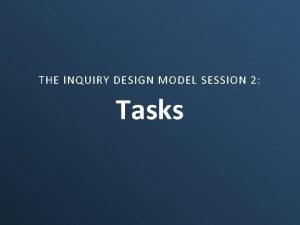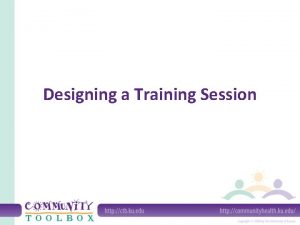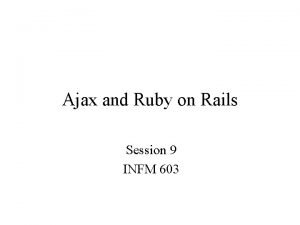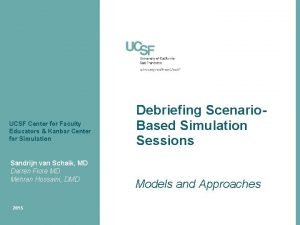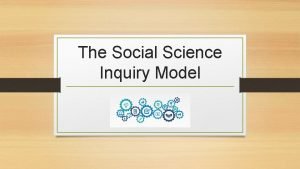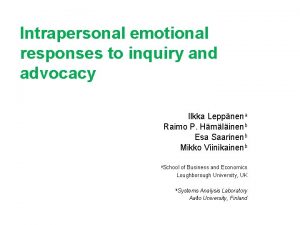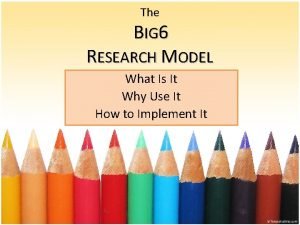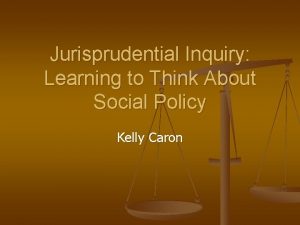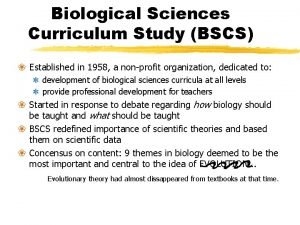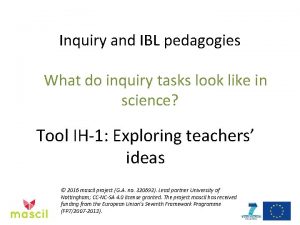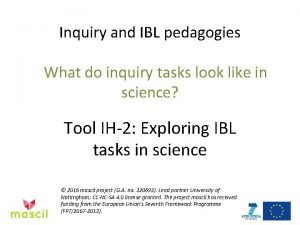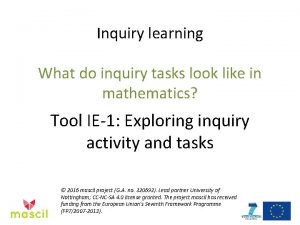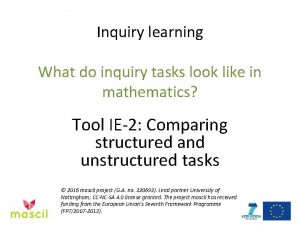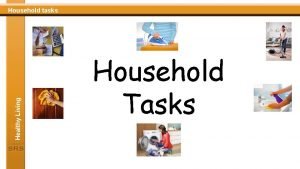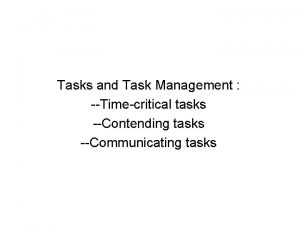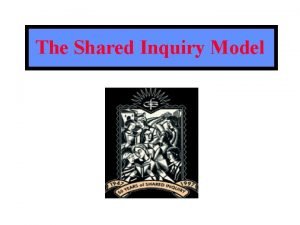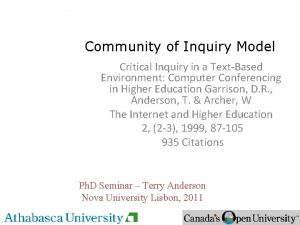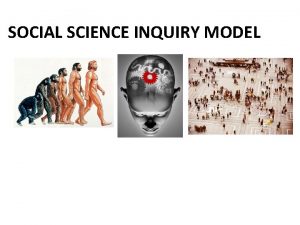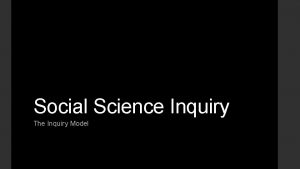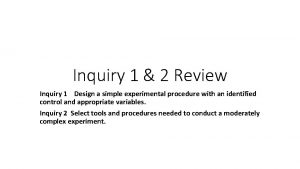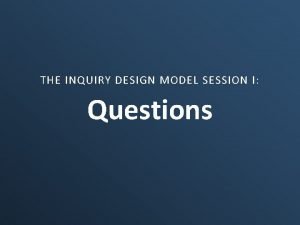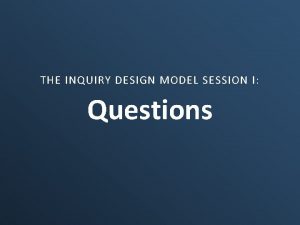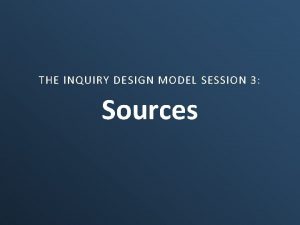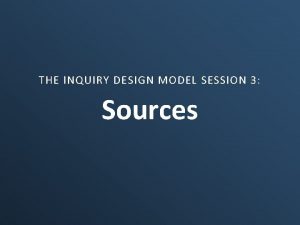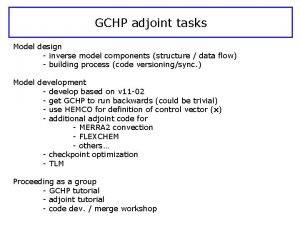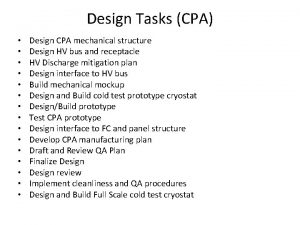THE INQUIRY DESIGN MODEL SESSION 2 Tasks Tasks























- Slides: 23

THE INQUIRY DESIGN MODEL SESSION 2: Tasks

Tasks in IDM • • Summative Performance Tasks Formative Performance Tasks Summative extensions Taking informed action

IDM Follows C 3 Inquiry Arc If students are asked a COMPELLING QUESTION… In the middle are the SUPPORTING QUESTIONS, FORMATIVE PERFORMANCE TASKS, and SOURCES Students answer in the form of a SUMMATIVE ARGUMENT


What is an argument? An argument is a collection of claims supported by relevant evidence, which can be considered an answer to the question investigated by the research. As arguments become more sophisticated, students might include counterclaims.

Uncle Tom’s Cabin: Can words lead to war? Argument stems: • Words can lead to war when words, such as the words in Uncle Tom’s Cabin, help people to express their disagreements with others. • The causes of the Civil War and most other wars are very complicated and cannot be boiled down to words in a book such as Uncle Tom’s Cabin. • It is difficult to determine the extent to which Uncle Tom’s Cabin contributed to the Civil War, but the book did support abolitionism.

Your Task • Consider the elements of a coherent, evidence-based argument as outlined in the seventh-grade Uncle Tom’s Cabin inquiry. – Can words lead to war? Construct an argument that discusses the impact of Uncle Tom’s Cabin using specific claims and relevant evidence from historical sources while acknowledging competing views. • Take a minute to write down the key elements that you would use to evaluate the argument.

Discussion • What elements make a coherent argument about Uncle Tom’s Cabin? • How should we support students in making a coherent argument?

IDM™ Follows C 3 Inquiry Arc If students are asked a COMPELLING QUESTION… In the middle are the FORMATIVE TASKS (Content and Skills) Students answer in the form of a SUMMATIVE ARGUMENT

Formative Performance Tasks • In order to make a coherent and evidenced-based argument – students need practice with argumentation skills – students need a strong content/conceptual foundation • This is where we get into formative work—there is no “gotcha” summative assessment. • These formative tasks are framed by the supporting questions. *NOTE: These formative tasks often follow a skill progression of increasing complexity.


Your Task Using the excerpted blueprint on the last slide, examine the formative performance tasks in the seventh-grade Uncle Tom’s Cabin Inquiry in relationship to the summative argument. In small groups, make a list of the ways that the formative performance tasks help students make a coherent, evidenced-based argument.

Additional Performance Tasks • Summative extensions • Taking informed action

Summative Extensions • Additional or alternative ways for students to express their arguments • In keeping with C 3 Framework: D 4. 3. 6 -8. Present adaptations of arguments and explanations on topics of interest to others to reach audiences and venues outside the classroom using print and oral technologies (e. g. , posters, essays, letters, debates, speeches, reports, and maps) and digital technologies (e. g. , Internet, social media, and digital documentary). • Included in all annotated inquiries

Examples of Summative Extensions

Taking Informed Action • Ways for students to civically engage with the inquiry • Sometimes action is embedded in summative performance task • In keeping with C 3 Framework – Step 1: Understand the problem – Step 2: Assess the problem – Step 3: Take action on the problem

Taking Informed Action

IDM™ Taking Informed Action Organize a fundraising event for an issue/cause Circulate a petition School Publish school newspaper special issue Organize a school assembly Upload a PSA to a website Classroom Locus of Activity Community Organize a boycott Research Issue relevant to Inquiry Understand Problem Identify problem(s) and possible civic action(s) Assess Options Complexity of the Effort Bring stakeholders together for a classroom forum. Write a letter to an editor Apply Action

Example of Taking Informed Action

Example of Embedded Action

Summary of Session 2: Tasks • Evaluating the content and conceptual knowledge as well as skills that make up the social studies is tricky business. • IDM features a variety of performance tasks that are outlined within the inquiry. • These tasks include: – consistent summative argument across all inquiries – series of formative performance tasks that prepare students for the summative tasks – additional performance tasks that allow students to express their arguments creatively and to engage civically

IDM Conceptual Framework: Tasks • The purpose of assessment is for learning (#5) • Students are active learners within an inquiry (#4) • Content knowledge and disciplinary skills are integrated within an investigation (#3) • Students need opportunities to practice engaged citizenship (#7) • Social studies shares in the responsibility for literacy (#8)

LOOKING AHEAD: Sources
 Inquiry design model example
Inquiry design model example Training session design
Training session design Microsoft technology centre
Microsoft technology centre Rails session model
Rails session model Kanbar center
Kanbar center Social science inquiry model 8 steps
Social science inquiry model 8 steps Advocacy inquiry model
Advocacy inquiry model Model big 6
Model big 6 Jurisprudential enquiry model
Jurisprudential enquiry model Biological sciences curriculum study
Biological sciences curriculum study Model based inquiry
Model based inquiry Hát kết hợp bộ gõ cơ thể
Hát kết hợp bộ gõ cơ thể Slidetodoc
Slidetodoc Bổ thể
Bổ thể Tỉ lệ cơ thể trẻ em
Tỉ lệ cơ thể trẻ em Gấu đi như thế nào
Gấu đi như thế nào Glasgow thang điểm
Glasgow thang điểm Hát lên người ơi
Hát lên người ơi Môn thể thao bắt đầu bằng từ đua
Môn thể thao bắt đầu bằng từ đua Thế nào là hệ số cao nhất
Thế nào là hệ số cao nhất Các châu lục và đại dương trên thế giới
Các châu lục và đại dương trên thế giới Công thức tính độ biến thiên đông lượng
Công thức tính độ biến thiên đông lượng Trời xanh đây là của chúng ta thể thơ
Trời xanh đây là của chúng ta thể thơ Mật thư anh em như thể tay chân
Mật thư anh em như thể tay chân
